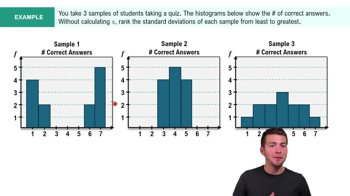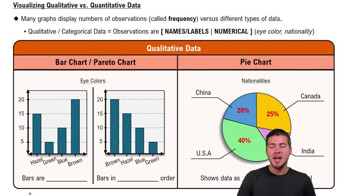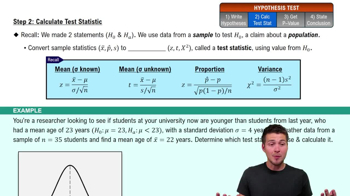Construct a 95% confidence interval for the mean difference of the population given the following information. Would you reject or fail to reject the claim that there is no difference in the mean?
Table of contents
- 1. Intro to Stats and Collecting Data1h 14m
- 2. Describing Data with Tables and Graphs1h 55m
- 3. Describing Data Numerically2h 5m
- 4. Probability2h 16m
- 5. Binomial Distribution & Discrete Random Variables3h 6m
- 6. Normal Distribution and Continuous Random Variables2h 11m
- 7. Sampling Distributions & Confidence Intervals: Mean3h 23m
- Sampling Distribution of the Sample Mean and Central Limit Theorem19m
- Distribution of Sample Mean - Excel23m
- Introduction to Confidence Intervals15m
- Confidence Intervals for Population Mean1h 18m
- Determining the Minimum Sample Size Required12m
- Finding Probabilities and T Critical Values - Excel28m
- Confidence Intervals for Population Means - Excel25m
- 8. Sampling Distributions & Confidence Intervals: Proportion1h 12m
- 9. Hypothesis Testing for One Sample3h 29m
- 10. Hypothesis Testing for Two Samples4h 50m
- Two Proportions1h 13m
- Two Proportions Hypothesis Test - Excel28m
- Two Means - Unknown, Unequal Variance1h 3m
- Two Means - Unknown Variances Hypothesis Test - Excel12m
- Two Means - Unknown, Equal Variance15m
- Two Means - Unknown, Equal Variances Hypothesis Test - Excel9m
- Two Means - Known Variance12m
- Two Means - Sigma Known Hypothesis Test - Excel21m
- Two Means - Matched Pairs (Dependent Samples)42m
- Matched Pairs Hypothesis Test - Excel12m
- 11. Correlation1h 6m
- 12. Regression1h 50m
- 13. Chi-Square Tests & Goodness of Fit1h 57m
- 14. ANOVA1h 57m
10. Hypothesis Testing for Two Samples
Two Means - Matched Pairs (Dependent Samples)
Problem 13.3.13a
Textbook Question
Rank Sums Exercise 12 uses Data Set 33 “Disney World Wait Times” in Appendix B, and the sample size for the 5:00 PM Tower of Terror wait times is n = 50.
a. If we have sample paired data with 50 nonzero differences, what are the smallest and largest possible values of T?
 Verified step by step guidance
Verified step by step guidance1
Understand the context: The problem involves paired data with 50 nonzero differences, and we are tasked with finding the smallest and largest possible values of the test statistic T, which is used in the Wilcoxon signed-rank test.
Recall that the Wilcoxon signed-rank test involves ranking the absolute values of the differences, assigning ranks from 1 to n (where n is the number of nonzero differences). In this case, n = 50, so the ranks range from 1 to 50.
The test statistic T is the sum of the ranks associated with either the positive or negative differences. To find the smallest and largest possible values of T, consider the extreme cases where all differences are either positive or negative.
For the smallest value of T, assume all differences are negative. In this case, T would be the sum of the ranks associated with the positive differences, which is 0 because there are no positive differences.
For the largest value of T, assume all differences are positive. In this case, T would be the sum of all ranks from 1 to 50. Use the formula for the sum of the first n integers: \( \text{Sum} = \frac{n(n+1)}{2} \), where n = 50, to calculate the total sum of ranks.
 Verified video answer for a similar problem:
Verified video answer for a similar problem:This video solution was recommended by our tutors as helpful for the problem above
Video duration:
3mPlay a video:
Was this helpful?
Key Concepts
Here are the essential concepts you must grasp in order to answer the question correctly.
Rank Sums
Rank sums refer to the total of the ranks assigned to the observations in a dataset. In non-parametric statistics, particularly in tests like the Wilcoxon rank-sum test, rank sums are used to compare two independent samples. Understanding how to calculate and interpret rank sums is crucial for analyzing paired data and determining statistical significance.
Recommended video:
Guided course

Calculating Standard Deviation Example 1
Paired Data
Paired data consists of observations that are linked or matched in some way, often representing two measurements taken on the same subjects. In the context of the question, the paired differences are essential for calculating the test statistic T. Recognizing the nature of paired data helps in applying the appropriate statistical methods for analysis.
Recommended video:
Guided course

Visualizing Qualitative vs. Quantitative Data
Test Statistic T
The test statistic T in the context of rank sums is a value calculated from the ranks of the differences between paired observations. It is used to assess the significance of the differences observed. Understanding how to determine the smallest and largest possible values of T is important for interpreting the results of the statistical test and making inferences about the population.
Recommended video:
Guided course

Step 2: Calculate Test Statistic

 8:33m
8:33mWatch next
Master Introduction to Matched Pairs with a bite sized video explanation from Patrick
Start learningRelated Videos
Related Practice
Multiple Choice
